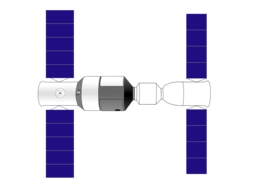Loading AI tools
2012 Chinese crewed spaceflight to Tiangong-1 From Wikipedia, the free encyclopedia
Shenzhou 9 (Chinese: 神舟九号) was the fourth crewed spacecraft flight of China's Shenzhou program, launched at 18:37:24 CST (10:37:24 UTC), 16 June 2012. Shenzhou 9 was the second spacecraft and first crewed mission and expedition to dock with the Tiangong-1 space station, which took place on 18 June. The Shenzhou 9 spacecraft landed at 10:01:16 CST (02:01:16 UTC) on 29 June in the Inner Mongolia Autonomous Region. The mission's crew included the first Chinese female astronaut, Liu Yang. The next mission was Shenzhou 10, which launched on 11 June 2013.[1]
You can help expand this article with text translated from the corresponding article in Chinese. (July 2012) Click [show] for important translation instructions.
|
 Diagram depicting Shenzhou 9 (right) docked with Tiangong-1 (left) | |
| COSPAR ID | 2012-032A |
|---|---|
| SATCAT no. | 38461 |
| Mission duration | 12 days, 15 hours and 25 minutes |
| Spacecraft properties | |
| Spacecraft type | Shenzhou |
| Crew | |
| Crew size | 3 |
| Members | Jing Haipeng Liu Wang Liu Yang |
| Start of mission | |
| Launch date | 16 June 2012, 10:37:24 UTC |
| Rocket | Long March 2F |
| Launch site | Jiuquan LA-4/SLS-1 |
| End of mission | |
| Landing date | 29 June 2012, 02:01:16 UTC |
| Orbital parameters | |
| Reference system | Geocentric |
| Regime | Low Earth |
| Docking with Tiangong-1 | |
| Docking date | 18 June 2012, 06:07 UTC |
| Undocking date | 24 June 2012, 03:08 UTC |
| Time docked | 3 days, 21 hours, 1 minute |
| Docking with Tiangong-1 | |
| Docking date | 24 June 2012, 04:38 UTC |
| Undocking date | 28 June 2012, 01:22 UTC |
| Time docked | 3 days, 20 hours, 44 minutes |
 (l-r) Jing Haipeng, Liu Wang, and Liu Yang | |
On 12 March 2012, it was announced that the initial crew selection roster for the mission included female astronauts.[2] The crew were unveiled to the press on 15 June. China's first female astronaut would be Liu Yang. Liu was selected ahead of her fellow female astronaut prospect Wang Yaping.[3] This mission also featured the first repeat astronaut, Jing Haipeng, the commander of the mission.[4] Shenzhou 9 was the 9th flight in China's Shenzhou program and the fourth crewed spaceflight. The mission's launch was 49 years to the day after that of the first woman in space, cosmonaut Valentina Tereshkova.[3]
The Shenzhou 9 spacecraft arrived at the Jiuquan Satellite Launch Center in the northwestern Gobi Desert on 9 April 2012 and its carrier rocket, the Long March 2F, arrived on 9 May.[5] On 9 June 2012, the Shenzhou 9 spacecraft and its carrier rocket were rolled out to launch pad.[6] On 12 June 2012 underwent system-wide joint exercises, and final health checks were completed the following day.
On 16 June 2012, the expedition ceremony was held at the Jiuquan Satellite Launch Center. National People's Congress Standing Committee Chairman Wu Bangguo attended the ceremony. The astronauts, Liu Wang, Liu Yang, and Jing Haipeng, rode to the launch tower and turned in the entrance with the assistance of support staff.[7]
The Long March 2F rocket was launched on 16 June 2012 at 10:37 UTC.
Shenzhou 9 docked with China's first space lab Tiangong-1 at 06:07 UTC on 18 June, marking China's first crewed spacecraft rendezvous and docking.[8][9] This docking was remotely controlled from a ground station.[10] After about 3 hours, when the pressures inside the vessels were equalized, Jing Haipeng entered into Tiangong-1.[11] Six days later, Shenzhou 9 detached from the station and then redocked manually under the control of crew member Liu Wang, making it the first manual docking for the Chinese program.[10]
Shenzhou 9 landed by parachute in Siziwang Banner, Inner Mongolia on 29 June 2012.[12]
The backup crew for the flight was:[13]
| Position | Crew member | |
|---|---|---|
| Commander | Nie Haisheng | |
| Operator | Zhang Xiaoguang | |
| Laboratory Assistant | Wang Yaping | |
The backup crew later became the prime crew for Shenzhou 10.[14]
Seamless Wikipedia browsing. On steroids.
Every time you click a link to Wikipedia, Wiktionary or Wikiquote in your browser's search results, it will show the modern Wikiwand interface.
Wikiwand extension is a five stars, simple, with minimum permission required to keep your browsing private, safe and transparent.